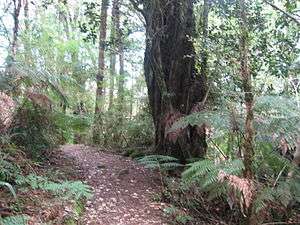Environmental issues in Chile
This page covers environmental issues in Chile.
Overview
The country of Chile is a virtual continental island bounded by the Pacific Ocean on the west, the Andes Mountains on the east, and the Atacama Desert in the north; it is home to several important ecoregions, such as the Chilean Winter Rainfall-Valdivian Forests, a biodiversity hotspot that harbors richly endemic flora and fauna, and the Tropical Andes, which stretches into northern Chile.[1]
There are endangered species in Chile, including the South Andean huemul, tundra peregrine falcon, puna rhea, Chilean woodstar, ruddy-headed goose, and green sea turtle. As of 2001, 16 species of mammals in a total of 91 were considered endangered. Of 296 breeding bird species, 18 were threatened with extinction. Also threatened were four types of freshwater fish and 268 plant species.[2]
Issues to face
There are a series of environmental issues in this country, with a dynamic and diversified economy. Chile's main environmental problems are deforestation and the resulting soil erosion.[2] From 1985 to 1995, Chile lost nearly 2 million hectares of native forest; these forests were destroyed for pulp, and made way for industrial tree farms. As a result, Chile now has the world's largest expanse of radiata pine tree farms and some of the world's most endangered native forests.[3]
Air pollution from industry and transportation and water pollution are especially acute in urban centers. In 1996, Chile's industrial carbon dioxide emissions totaled 48.7 million metric tons. Untreated sewage poses the major threat to the nation's water quality. As of 2001, Chile had 928 cu km of renewable water resources. While 99% of its urban dwellers have pure drinking water, only 58% of its rural dwellers have the same access.[2]
Chile is one of the major mining countries of the world and big-scale mining also represents an important environmental challenge. Severe water shortages affecting many local communities were due not only to persistent drought but to structural problems in the policies governing the exploitation of natural resources, including privatized water management; this led to big protests.[4]
See also
- Valdivia Pulp Mill controversy
- VLCC Metula oil spill
- Pascua Lama mining project
- Environmental Water Quality Chile
References
- ↑ Chile - Encyclopedia of Earth
- 1 2 3 "Chile-Environment". NationsEncyclopedia.com. Retrieved 19 January 2014.
- ↑ "Plantations in Chile trampling native forests". WWF. Retrieved 19 January 2014.
- ↑ "Mining and logging companies 'leaving all of Chile without water'". The Guardian. 24 April 2013.
External links
- "Key Environmental Issues in Chile". GRRT. Retrieved 19 January 2014.

